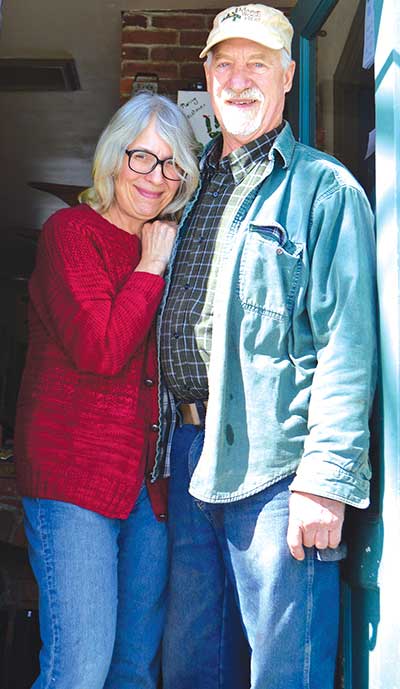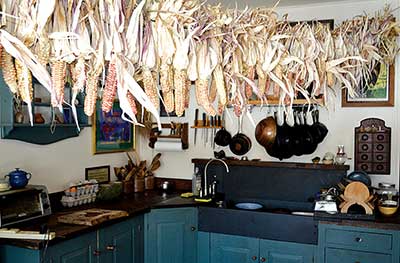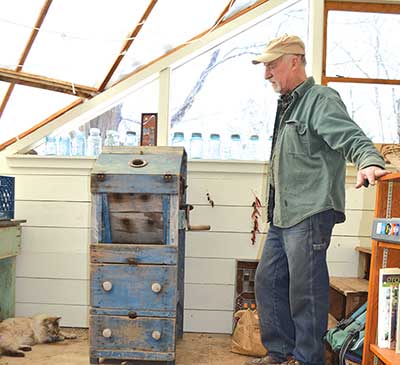 |
| Michele Carmel and Albie Barden at their Norridgewock home. |
 |
| One aspect of “living with the corn.” |
 |
| A Benjamin & Co. model corn sheller made in Winthrop in the 1800s |
By Jean English
Photos by the author
“We live with the corn, in all of its manifestations.”
Michele Carmel’s understatement amuses me as I sit with Albie Barden and Carmel in their Norridgewock kitchen, knocking my head on the corn hanging above when I get up, glancing at the corn sheller in the dining room, admiring the corn-inspired art on the wall and savoring corn pudding – all near the banks of the Kennebec River where corn has grown for centuries.
Barden’s memories of corn go back to childhood, to his Rhode Island relatives’ annual summer visits to Maine. They always brought 5-pound boxes of Narragansett/Pequot white flint corn, stone-ground in Rhode Island at Kenyon’s Grist Mill, for making jonny cakes. Coincidentally, Barden later bought his Maine farm in a historic corn-growing region. “The valley in Norridgewock and the flood plains of the Kennebec were principal growing areas for massive quantities of corn and appear to have been part of the trade network,” Barden says. “The Norridgewock people would travel to the coast every summer and come back in the fall, with some trips in between.”
He notes that historically fish showed up in the Kennebec River just when the soil was warm enough to plant corn. Availability of that fertilizer “was a beautiful balance.”
Sourcing Varieties
Barden grew sweet corn for years, beginning in childhood, and got interested in flint corn about 20 years ago when Will Bonsall of Industry, Maine, sent him a packet of the Byron variety. He planted it, but when the corn ripened, his horses “blew through the electric fence and ate every stalk to the ground. That taught me that you can’t stop the animals if they’re determined – and how delicious Byron must be.”
Years later, while teaching a class on plant spirit medicine for Gail Edwards of Blessed Maine Herb Company, he noticed that the man who was keeping a sacred fire at the gathering was holding a beautiful ear of a cream- and rose-colored corn. The man, Tim Goodblood, part Micmac, said that an Abenaki woman in New York had provided the corn. He gave Barden 12 kernels, which produced 23 ears. Barden was hooked and has since given away thousands of Abenaki Rose kernels. This is a flour corn rather than a flint corn, according to Maine farmer Tom Vigue, who cut a kernel open and noticed its thin outer layer (pericarp); flint corn has a thick pericarp that is said to be hard as flint.
Next, Brian Connolly, a farmer and professor in Western Massachusetts, sent Maine Hubbard, Knowlton and Fort Kent flint varieties to Barden, who kept the first two, while Tristan Noyes of the Maine Grain Alliance grew Fort Kent – probably a Micmac corn – on his Aroostook farm.
Barden also acquired Gaspe flint from Indiana seed saver John Sherck, who got it from a Saskatchewan farmer. This is the variety Champlain saw Native people tending when he sailed up the St. Lawrence in 1604. Anne Mefferd at One Drop Farm in Cornville, Maine, is the current caretaker of Gaspe flint.
Connolly also connected Barden with seed saver Steve McComber, a Mohawk elder in Kahnawake, near Montreal. McComber gave Barden four Native heirloom varieties of flint corn, including Six Nation Blue, which Barden grew in 2017. In 2018 some of it sprouted from kernels on an ear that had fallen to the ground and wintered over in 2017. “That says something about the incredible vigor and the nature of that hard flint shell that protects it so well,” says Barden. “It wasn’t accidental that it got developed by Indigenous people for the Northeast.”
At the Maine Agricultural Trades Show in Augusta, the Weston family of Fryeburg told Richard Roberts, who oversees the heritage grain project for the Maine Grain Alliance, that they had been growing an old flint corn for generations. Barden tracked down that seventh-generation farm and received some of its corn.
He is also obtaining the heirloom Maine flint corn Twitchell’s Pride from a seed bank; this was grown in Ontario and Quebec in the 1800s and 1900s.
Father Sebastian Rasle, who lived for 33 years with the Indigenous people of Norridgewock in the early 1700s, described in his Abenaki dictionary a Norridgewock corn called “Chipmunk” in Abenaki, because it had alternating stripes down its length. Barden has yet to find this variety.
Spreading Seed, Meeting Demand
Maine businesses, including Blue Ox Malthouse, Maine Grains and Tortilleria Pachanga, have told Barden they would like to buy Maine flint corn. So Barden and Carmel grow a particular variety until they can give 10 pounds to someone, such as Sean and Sandra O’Donnell of Rusted Rooster Farm in Parkman, who have grown Darwin John and Byron. The O’Donnells dry their corn in totes in a hoophouse, with air blowing through perforated PVC tubes in the totes.
Of the heirlooms Barden has gathered, Byron is most ready for distribution. Pam Prodan of Wilton, Maine, got Byron kernels from Will Bonsall 15 or 20 years ago; Bonsall got it from the Mosher family of Wilton. Prodan has hand-pollinated, selected and multiplied the variety with care, increasing its availability. Now Barden is seeking five to 10 farmers to grow half-acre to 1-acre plots of Byron.
Other varieties – Gigi Hill, Six Nation Blue, Darwin John – are available in more limited quantities and could be grown on some 1-acre plots.
The growing season varies dramatically among Maine flint corns. Gaspe matures in about 65 to 75 days; Darwin John in about 80; and Byron, 100 to 120 days. Conrad Heeschen told Barden that he and Prodan try to sow Byron by Memorial Day, and it’s ready to harvest in time to enter in the Exhibition Hall at MOFGA’s Common Ground Country Fair.
The soil should be warm for planting, and the corn should be protected with 2-foot Flexnet-type fencing from porcupines and other small animals as well as two strands of electric wire for deer.
To avoid cross pollination, some sources recommend a half mile distance from other corn; others say 1,000 feet. Timing can prevent cross pollination, too. Gaspe and Knowlton flower 15 days apart, so they can be planted at the same time. Hand pollination and bagging are also effective.
Saving and Sharing Shellers, Too
The Somali Bantu farmers, while in refugee camps for 18 to 20 years, managed to save their corn and now grow it in Maine, says Barden. They had been shelling thousands of pounds by hand until Barden gave them a corn sheller he got from Uncle Henry’s that someone had gotten at the Readfield dump. The Somalis restored it and put it in their storefront in Lewiston. Somali families now come there to shell their corn.
Chris Coulling of Mount Vernon found and restored three shellers. He sold two to Barden at cost, and last fall Coulling and his wife, Elizabeth Hart, brought one to the Nibezun harvest festival of the Wabanaki community. They and Barden shelled and ground Oaxacan green corn there to make jonny cakes.
The old shellers Barden has acquired have cast iron parts that can be adjusted for ear size. Barden demonstrated a sheller that Coulling restored, which spits cobs and kernels out onto the floor, and the old Benjamin & Co. model (made in Winthrop in the 1800s), which neatly separates cobs from kernels into separate drawers.
Interested in growing heirloom flint corn to help increase the supply? Contact Barden and Carmel at [email protected]. “We are especially looking for ‘cornservators,’ folks who will grow the corn as a focused task and give back a portion of their harvest to expand the seed bank for the future and to give back flint corn seed to Indigenous people wherever they are,” they say.
